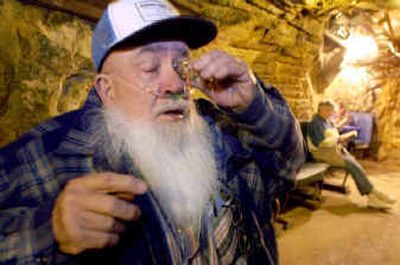Radon love

BASIN, Mont. — Is health, like beauty, in the eye of the beholder?
If that’s the case, thousands of people every year find healing relief from a variety of ailments — from cataracts and emphysema to arthritis and migraine headaches — at Montana’s most unusual health facilities — the radon health mines of Boulder and Basin, Mont.
The two small towns, located a few miles apart between Butte and Helena on Interstate 15, are the only known places in North America where people come and pay to breathe the radioactive radon gas that occurs naturally in the mines — for their health.
Radon is a gaseous radioactive element that is derived from the radioactive decay of radium, according to the U.S. Environmental Protection Agency, which calls it “extremely toxic.”
The Montana public health agency “doesn’t encourage (the mines’) use,” said Dr. Todd Damrow of the Montana Department of Public Health and Human Service. “But people are free to use them.”
And they do, by the thousands every year. Many people make annual pilgrimages to the Merry Widow and the Earth Angel mines in Basin, and the Free Enterprise and Lone Tree mines in Boulder. Owners of the mines dismiss the EPA warnings about radon as “government propaganda.”
“It’s not harmful at all,” said Patricia Lewis, owner of the Free Enterprise Mine.
The opinion of many physicians, however, is altogether different.
“It’s hard to believe that something like radon, which we know to be a carcinogen, people will pay to go sit and inhale it,” said Dr. Peggy Schlesinger, a Missoula physician specializing in arthritic conditions.
But people suffering from the chronic pain of arthritis are often desperate, she said.
“People are always looking for alternative treatments,” Schlesinger said. “But radon is a clear, bad actor. It’s a carcinogen. I don’t get it.”
Dwayne Knutzen, owner of the Merry Widow, was visiting the Basin area from Washington four years ago and found the mine and its campground for sale.
“I was like everybody else,” he said. “Radon? That can’t be good for you.”
But the more he researched, he said, the more he was convinced.
“The only reason I bought the place is it’s so fascinating,” Knutzen said. “You hear all these bad things. But you can’t ever find anybody who died from it. And there are all these benefits.”
Arthritis is the most common malady of people seeking relief in the radon mines, according to Knutzen.
He estimated that a couple of thousand people visit the Merry Widow for therapy every year.
“They come from everywhere — the Philippines, Europe, the U.S., Canada,” he said. “A lot come every year. One guy has come every year since 1962. He’s 95 now.”
Knutzen charges $3.50 for one-hour “treatments” in the mine.
“The biggest bang for your buck is the first hour,” he said. “You go in for an hour. Your blood stream will absorb the maximum amount in the first half hour. Then your skin absorbs it. Most people make three visits a day for about 10 days, usually 30 to 32 hours while they’re here.”
“There are tons of skeptics,” he said. “I’ve gotten lots of testimonials from them too. They’re the best ones.”
Schlesinger attributes the testimonials for the radon health mines, in part, to a placebo effect. Visitors expect to feel better, she said, so they do.
“There’s a 30 percent placebo response to anything,” Schlesinger said. “And I’m grateful for whatever works to make people feel better. … But I wish they’d take the radon out and just go to the mine.”
People should be aware, she added, that there have been significant, major advances in the medical treatment of arthritis in the past five years.
“All in all,” she said, “it is a great time to have arthritis.”